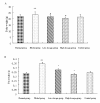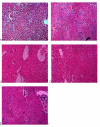Anti-obesity effect of an isoflavone fatty acid ester on obese mice induced by high fat diet and its potential mechanism
- PMID: 20482839
- PMCID: PMC2889992
- DOI: 10.1186/1476-511X-9-49
Anti-obesity effect of an isoflavone fatty acid ester on obese mice induced by high fat diet and its potential mechanism
Abstract
Background: The novel compound 1a is one of the isoflavone fatty acid esters. In order to investigate the anti-obesity effect of compound 1a and its potential mechanism of influence in adipocyte differentiation, Obese male C57BL/6J mice induced by high-fat diet (HFD) and rat preadipocytes (3T3-L1 cell) were used.
Methods: After 4-week HFD induction, the obese model was made successfully. After treatment with compound 1a, mice plasma biochemistry parameters were analyzed. In addition, mice hepatic tissue slice was observed. In in vitro research, 3T3-L1 cell differentiation by Oil-Red-O staining and adipocyte apoptosis was detected by flow cytometry.
Results: The in vivo results implied that compound 1a significantly decreased the body weight, white adipose tissue weight of obesity mice (p<0.05), reduced leptin and TG in plasma (p<0.05), elevated HDL-C in serum (p<0.05). The in vitro results suggested that compound 1a could significantly suppress the adipocyte viability and lipid accumulation in the differentiation of preadipocyte, and induce apoptosis in both preadipocytes and mature adipocytes (p<0.05).
Conclusion: Compound 1a regulates serum lipid profiles, decreases adipose tissue mass and body weight gain by inducing adipocyte apoptosis in high fat diet induced mice. Thus, it may be used to treat obese patients with hypercholesterolemia and hypertriglyceridemia.
Figures







Similar articles
-
Ramalin inhibits differentiation of 3T3-L1 preadipocytes and suppresses adiposity and body weight in a high-fat diet-fed C57BL/6J mice.Chem Biol Interact. 2016 Sep 25;257:71-80. doi: 10.1016/j.cbi.2016.07.034. Epub 2016 Jul 30. Chem Biol Interact. 2016. PMID: 27481193
-
Eicosapentaenoic acid reduces adipocyte hypertrophy and inflammation in diet-induced obese mice in an adiposity-independent manner.J Nutr. 2015 Mar;145(3):411-7. doi: 10.3945/jn.114.202952. Epub 2014 Dec 31. J Nutr. 2015. PMID: 25733455
-
Defatted safflower seed extract inhibits adipogenesis in 3T3-L1 preadipocytes and improves lipid profiles in C57BL/6J ob/ob mice fed a high-fat diet.Nutr Res. 2016 Sep;36(9):995-1003. doi: 10.1016/j.nutres.2016.07.004. Epub 2016 Jul 25. Nutr Res. 2016. PMID: 27632920
-
Fermented Platycodon grandiflorum Extract Inhibits Lipid Accumulation in 3T3-L1 Adipocytes and High-Fat Diet-Induced Obese Mice.J Med Food. 2016 Nov;19(11):1004-1014. doi: 10.1089/jmf.2016.3805. Epub 2016 Oct 28. J Med Food. 2016. PMID: 27792464
-
Adipocyte-based high throughput screening for anti-obesity drug discovery: Current status and future perspectives.SLAS Discov. 2022 Oct;27(7):375-383. doi: 10.1016/j.slasd.2022.08.001. Epub 2022 Aug 7. SLAS Discov. 2022. PMID: 35948270 Review.
Cited by
-
Changes in Plasma Metabolites Concentrations in Obese Dogs Supplemented With Anti-oxidant Compound.Front Nutr. 2018 Sep 7;5:74. doi: 10.3389/fnut.2018.00074. eCollection 2018. Front Nutr. 2018. PMID: 30246011 Free PMC article.
-
Natural Dietary and Herbal Products in Anti-Obesity Treatment.Molecules. 2016 Oct 11;21(10):1351. doi: 10.3390/molecules21101351. Molecules. 2016. PMID: 27727194 Free PMC article. Review.
-
Gut microbial change after administration of Lacticaseibacillus paracasei AO356 is associated with anti-obesity in a mouse model.Front Endocrinol (Lausanne). 2023 Aug 29;14:1224636. doi: 10.3389/fendo.2023.1224636. eCollection 2023. Front Endocrinol (Lausanne). 2023. PMID: 37705572 Free PMC article.
-
Preclinical Pharmacokinetics and Pharmacodynamics of Coptidis Preparation in Combination with Lovastatin in High-Fat Diet-Induced Hyperlipidemic Rats.ACS Omega. 2021 Jun 10;6(24):15804-15815. doi: 10.1021/acsomega.1c01201. eCollection 2021 Jun 22. ACS Omega. 2021. PMID: 34179624 Free PMC article.
-
Gut microbiota and fecal volatilome profile inspection in metabolically healthy and unhealthy obesity phenotypes.J Endocrinol Invest. 2024 Dec;47(12):3077-3090. doi: 10.1007/s40618-024-02379-2. Epub 2024 Jun 21. J Endocrinol Invest. 2024. PMID: 38904913 Free PMC article.
References
-
- Formiguera X, Canton A. Obesity: epidemiology and clinical aspects. Best Pract Res Clin Gastroenterol. 2004;18:1125–1146. - PubMed
-
- Kim HK, Nelson-Dooley C, Della-Fera MA, Yang JY, Zhang W, Duan J, Hartzell DL, Hamrick MW, Baile CA. Genistein decreases food intake, body weight, and fat pad weight and causes adipose tissue apoptosis in ovariectomized female mice. J Nutr. 2006;136:409–414. - PubMed
-
- Vettor R, Rossato M. The blockade of the endocannabinoid CB1 receptors and its influence on cardiometabolic risk: Lesson from Rimonabant In Obesity (RIO) trials. International Congress Series. 2007;1303:146–154. doi: 10.1016/j.ics.2007.03.025. - DOI
MeSH terms
Substances
LinkOut - more resources
Full Text Sources
Medical
Miscellaneous

